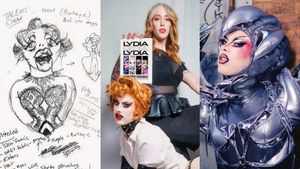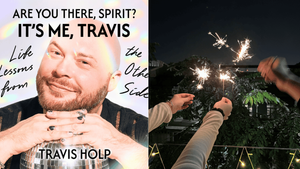When Cindy Williams of Laverne & Shirley fame died this week, it brought back an unexpected flood of memories about that iconic show as well as another era that seemed so innocent until it wasn’t. Williams’s death also makes you question your own mortality, because if you remembered tuning in weekly to Laverne & Shirley while you were growing up, Williams is just another in a long line of TV show stars from your impressionable years who have passed.
I’m going to say this as politely and respectfully as I can, but if you watch Laverne & Shirley, which was a spin-off of Happy Days, now, the humor can seem dated and stale. I tried to do that not too long ago, and I found myself rolling my eyes. But that’s only because these two television shows were mostly white, mostly simple, and mostly family-centric. They were depicting the prominent thinking of what life should be like in the ‘50s and early '60s, after all, a time of Ike, white picket–fenced homes, stay-at-home moms in dresses, and square dads who worked 9-5. Repression was a word not to be spoken.
Happy Days was a huge hit, and that’s because it was built around the formula of success of that day: It was about a happy white middle-class family from Milwaukee, with everyone’s mom, “Mrs. C"; dad Howard Cunningham; one teen girl, Joanie; and one teen boy, Richie a.k.a. Opie a.k.a. Ron Howard.
A second son, Chuck, mysteriously disappeared after the first season.
As I was writing that, I had the wild idea that maybe during a semester break from college, Chuck came home and told his parents, Marion and Howard, that he was gay. Mr. and Mrs. Cunningham always seemed so accepting. They let the rogue Fonzie into their home, but perhaps being gay was all too much. Maybe they kicked Chuck out of his home, making him like many other gay young men who became homeless during that time.
The greaser Fonzie, played by Henry Winkler, became an international superstar. If Fonzie was around during the #metoo movement, there would be a class action lawsuit against him for his comments and behavior; however, it was this lust for women that opened the door for Laverne, played by the late Penny Marshall, and Shirley, played by Williams, to be introduced to America. Their hilarious appearance on Happy Days was the reason that they got their own show.
If you’re a man of a certain age, you can probably confess to a crush on Fonzie. Many girls had posters of him in their room. I couldn’t figure out exactly why, but there was something about Fonzie that piqued my interest in a provocative way. Winkler had a great head of hair and was good-looking, but he was short and wasn’t muscular, so one wonders if he’d have the same sultry effect today that he did over 40 years ago.
And if you’re a woman of a certain age, your interest might have been piqued about Laverne and Shirley living together, always playfully touching each other or wrestling each other out of some bizarre circumstance — in entertainment parlance, slapstick. Or showing their love for each other at the end of each episode.
Yes, they dated men, fantasized about being swept off their feet, and yearned to marry so they could quit their jobs at the brewery. Laverne went with Shirley like pretzels go with Shotz beer. They just ran with each other and all over each other. You were sometimes left wondering why they even bothered to be desperate about men when they shared such a happy life together, hidden away in a basement apartment.
I remember when I was a young boy, two women lived together down the street from my great-grandmother, in a small town in southwestern Pennsylvania. They were called spinsters, which was code back then for living in sin, another way of saying "lesbian" or implying the truth that dare not speak its name. The show had to go off the air eventually because Laverne and Shirley couldn’t grow old and still be living with each other and be known as old maids, another queer code word.
Then there’s Lenny and Squiggy, who were roommates, also fell all over each other, and were only compatible with each other. Their success with women was nonexistent. Remember, back in this time, gay men were still depicted as freaks whose success with women was also nonexistent. So the fact that Lenny and Squiggy were such oddballs, sans women, would have made them stereotypically suitable back then.
Laverne and Shirley's and Lenny and Squiggy’s relationships weren’t intentionally sexualized. This was the '70s, and these shows were straight down the middle — literally — yet there was something different about two men and two women living with each other. And that studly Carmine, Shirley’s on-again, off-again beau. There again, Shirley just couldn’t make that relationship with the opposite sex stick. He was her boyfriend, then her boy friend, which seemed more appropriate.
And when Carmine took his shirt off, as was his wont, I can still remember being mesmerized, and only later did I realize why. The guy had pecs and guns, and was much more of a beefcake than Fonzie.
I can just see some heterosexuals reading this, shaking their heads, and saying. “He’s warping a perfectly innocent show into some homosexual romp.” That’s not it at all. I know Laverne, Shirley, Lenny, Squiggy, Fonzie, and, unfortunately, Carmine were all written as straight. That’s not the point.
It was the fact that there was no representation of normalized gay or lesbian characters on television or in pop culture at the time, so you had to create them in your own mind or at least try to figure out a way to convince yourself that underneath it all was a secret subtext that would reveal these characters to be gay, even if it was erroneous. That’s all we had to think about, to hold on to, and to hope for.
Today’s youth have boatloads of television shows that include a plethora of gay, lesbian, trans, nonbinary, queer characters. Streaming services have LGBTQ +categories with lots of options to choose from. With today’s television characters, there’s no need to create a fictitious background or imagine an illicit love or hope that somebody harbors a secret.
Shirley once said, “I treat my body like a temple, Laverne. You choose to treat yours like an amusement park.” What do you think she meant by that?
John Casey is editor at large for The Advocate.
Views expressed in The Advocate's opinion articles are those of the writers and do not necessarily represent the views of The Advocate or our parent company, equalpride.





































































Charlie Kirk DID say stoning gay people was the 'perfect law' — and these other heinous quotes